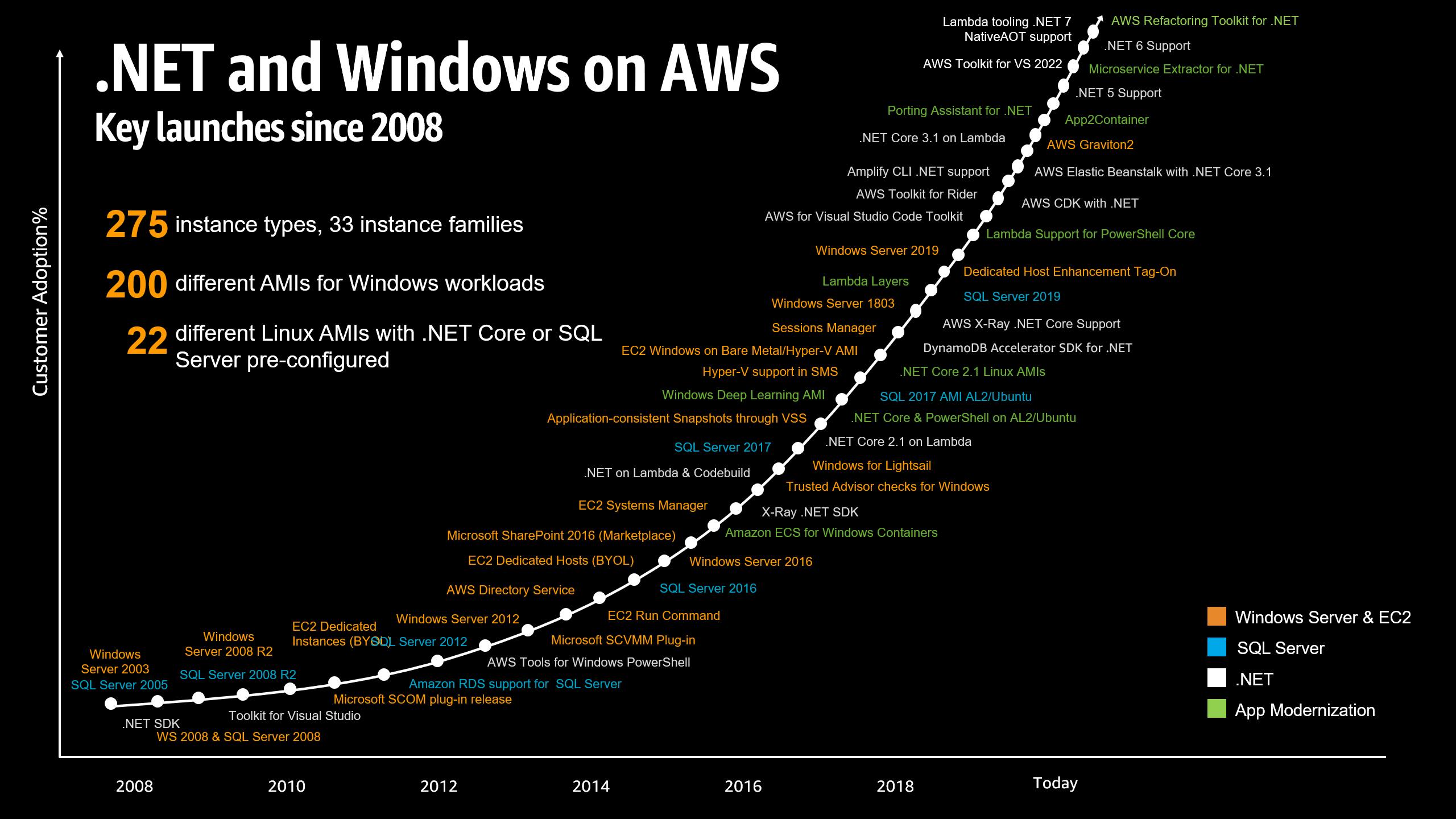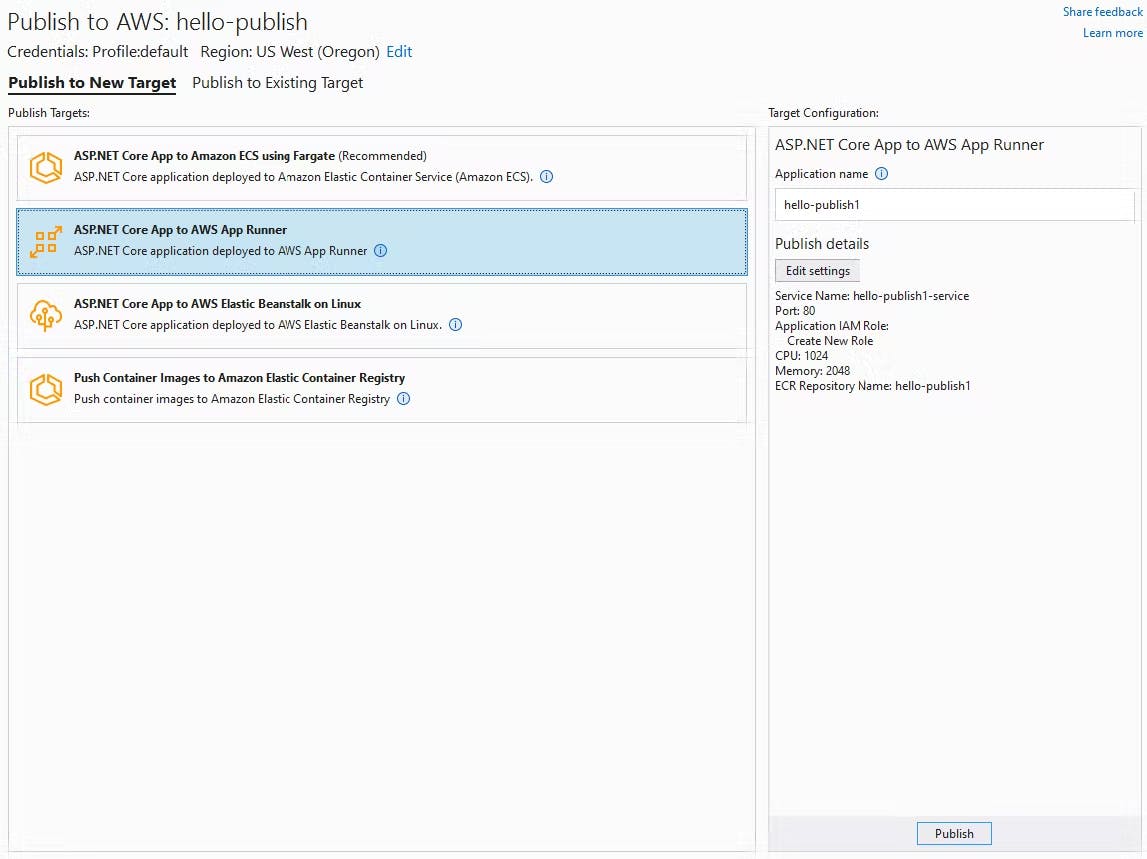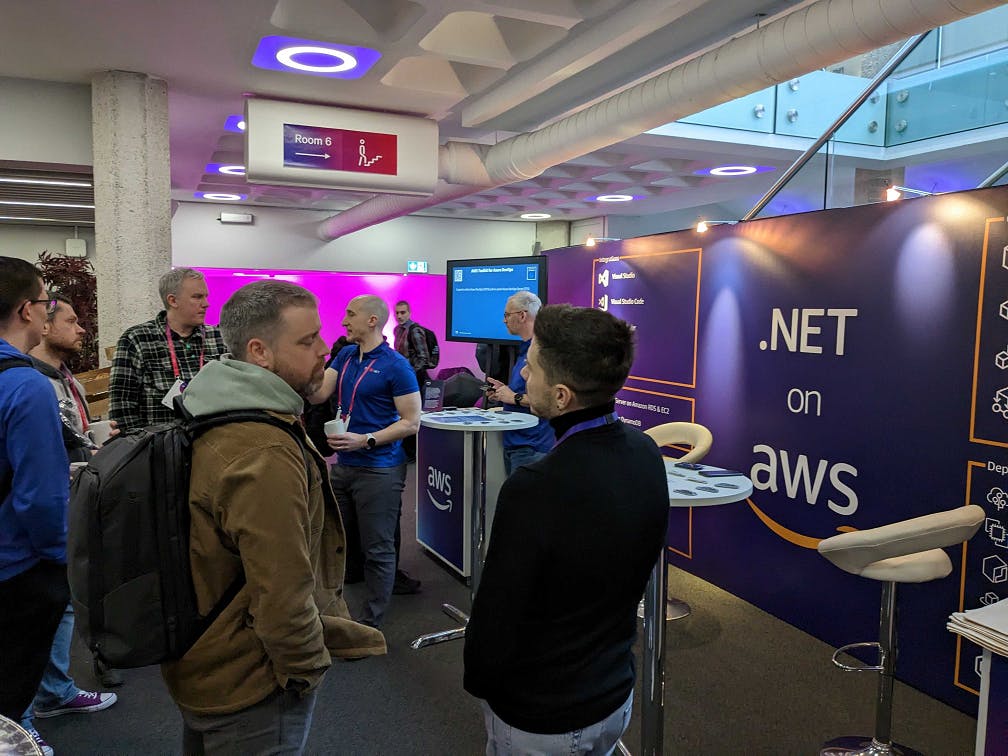If you're a .NET developer, it's likely you're already running applications in the cloud or are making plans to. But which cloud is best for your .NET workloads? If you haven't taken a look at AWS recently, here are 7 reasons why AWS is worth exploring.
1. Our Commitment to .NET
Did you know that AWS has been supporting .NET since 2008, longer than any other cloud provider? AWS continues to deliver a steady stream of support for .NET on Windows and Linux. We have product teams, engineering teams, and developer advocacy teams solely dedicated to the .NET platform. In short, AWS ♥ .NET.

2. Innovation that empowers you
Developers should expect innovation from their cloud provider, which in turn empowers you to innovate more on behalf of your customers. AWS regularly innovates with compelling infrastructure, software, and hardware offerings that give you new capabilities, simplify management, or reduce cost. Here are a few examples:
Since its introduction in 2014, AWS Lambda has propelled the serverless movement.
Arm-based Graviton processors were released in 2018, and are now in their third generation. .NET applications have gained as much as 40% better price-performance on Graviton2 processors.
The AWS Nitro System combines purpose-built hardware and a lightweight hypervisor. This allows AWS to innovate faster while devoting virtually all of the power of host hardware to your application instances.

How about something .NET-specific? AWS doesn't merely support .NET, we let you leverage the newest features and performance in your cloud applications. Just one week after .NET 7 went GA, AWS released tooling support to build and deploy NativeAOT compiled .NET 7 applications to AWS Lambda.
3. Managed services make it easy(er)
AWS has come a long way since its original Elastic Compute Cloud (EC2) compute service. Today, you can choose the level of control you want, from the full control that EC2 gives you, to managed container services (Amazon ECS, Amazon EKS), to serverless AWS Lambda, to fully-managed "leave the driving to us" services like AWS App Runner. Take a look at our managed services, and our guided Publish to AWS experience from Visual Studio or the command line.

And yes, we still have work to do. The hundreds of services available from AWS can seem overwhelming to a newcomer, and we're working constantly to make things easier and improve the getting started exprerience. Managed services don't give you a pass on correctly configuring security, which AWS is fiercely dedicated to and you should be also. For a helpful overview of how AWS security works and what it means for .NET developers, check out Developer Advocate Isaac Levin's video, AWS for the .NET Developer - AWS Concepts and Security.
4. Superb .NET Modernization Tools
AWS offers migration and modernization tools specifically designed for .NET workloads. There's no additional charge for these tools.
For simple lift-and-shift migration of your ASP.NET web applications running in IIS on Windows, you can use AWS App2Container to containerize and deploy to AWS without code changes.
To modernize your legacy .NET framework applications to modern .NET that you can run on Linux, you can use Porting Assistant for .NET. This analysis tool scans your .NET framework applications and generates a .NET Core compatibility assessment, helping you port to Linux faster. It suggests replacements for incompatible packages and APIs, such as moving from WCF to CoreWCF.
To transform your monolithic application to a microservices architecture, you can use AWS Microservice Extractor for .NET. MSE simplifies the process of refactoring with progressive extraction of code groups to separate microservice code repositories. It provides AI-driven recommendations.

5. Our Community Presence
We are fully present in the .NET community to help you and support you. View the .NET on AWS Community Page to find connections to the vibrant .NET on AWS community. .NET-focused AWS Community Builders, including sponsored .NET influencers around the world, regularly produce helpful .NET on AWS content viewed by hundreds of thousands of developers. Start following them and you'll be tuned in to news, events, and technical content.
Follow YouTube creators Nick Chapsas (UK), Rahul Nath (Australia), and Wes Doyle (US).
Follow bloggers Mukesh Murugan (India) and Rahul Nath.
Tune in to the Cloud Champions podcast from Andrea Saltarello (Italy).
Our .NET developer advocates and cloud architects publish blogs, videos, podcasts, technical guides, courses, and books, with new content every week.
Check out Bryan Hogan's popular No Dogma Blog and podcasts.
View David Pallmann's Hello, Cloud blog for getting started tutorials.
Watch Isaac Levin's AWS for the .NET Developer videos and Coffee & Open Source podcasts.
You can watch Steve Roberts regularly on AWS on Air livestream shows.View Tom Moore's Basement Programmer blog, videos, and podcasts.
Read Paris-based François Bouteruche's blog.
Tune in to James Eastham's YouTube channel for great serverless videos.
You'll run into our developer advocates regularly at .NET conferences around the world including NDC. We also present regularly at .NET User Group meetups. DM me to arrange a presentation.

AWS is also a strong supporter of the .NET open source community. We both sponsor OSS projects and contribute to .NET projects and .NET itself.
6. We'll Listen to You
.NET developers should take a look at AWS because we'll listen to you. If your image is of a faceless tech giant unconcerned about customers, think again when it comes to AWS. Customer-obsession is part of Amazon's DNA. Every single team and employee are driven to delight our customers, and that's how we're evaluated. That begins with customer feedback, and .NET developers are my team's customers. You are our priority.

Do you have something to tell us about your .NET on AWS experience? We'd be happy to set up a customer interview so product managers and engineers can hear about your pain points, questions, or challenges. If you'd like to schedule a call, reach out to Developer Advocate Tom Moore. Don't hestitate, we really want to hear from you. Your feedback is what drives our engineering investments for .NET.
7. To Gain Perspective

AWS is a leading cloud platform, which makes it worth evaluating against other cloud platforms. You may well discover unique capabilities of value to your business, compelling cost savings and price-performance, appealing infrastructure and SLAs, and beneficial programs to developers and organizations. AWS has more than 100,000 partners in 150 countries.
AWS’s breadth of capabilities sets the standard for cloud service innovation. For the twelfth consecutive year, AWS has been named as a Leader in the 2022 Magic Quadrant for Cloud Infrastructure and Platform Services (CIPS). Per Gartner, AWS is the longest-running CIPS Magic Quadrant Leader. Read the report to discover why Gartner again positioned AWS as a Leader, and try AWS for yourself.
How to Try AWS
If even one of the above reasons intrigues you, or it's been a long time since you last looked at AWS, it's worth taking a look at AWS today. To try AWS, visit and bookmark the .NET on AWS developer hub, learn about AWS, open an account, and build something.
You can explore AWS on us, by requesting developer credit. Just send an email request to dotnet-on-aws-feedback@amazon.com with AWS CREDIT in the subject line, and we'll issue you a one-time developer credit. Learn about the AWS Free Tier, which gives you a certain amount of free play on different services. Some of the free tier allowances are quite generous. For example, the AWS Lambda free tier includes one million free requests per month. Read the service pricing pages for specific details.
Build a .NET on AWS application, and share your experiences in the comments.
